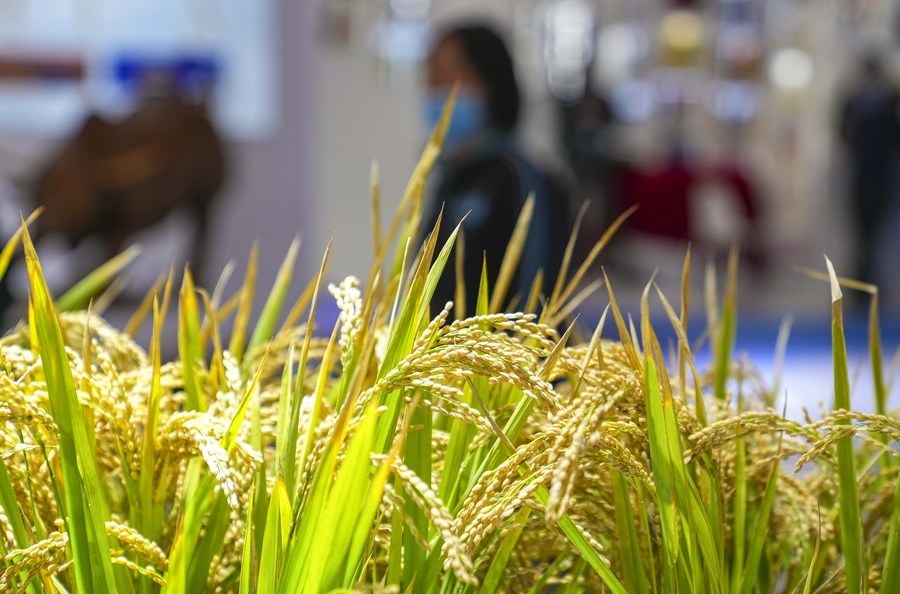Saline-alkali land transformed into fertile soil in east China

People watch samples of saline-alkali tolerant rice at the 13th China-Northeast Asia Expo in Changchun, northeast China's Jilin Province, on Sept. 24, 2021. (Xinhua/Xu Chang)
HANGZHOU, Nov. 10 (Xinhua) -- Rice stalks bend under the weight of golden rice ears in Shuihutu Village, Xiangshan County of east China's Zhejiang Province.
The day before Lidong, the beginning of winter according to the traditional Chinese solar calendar, the paddy field welcomed its first bumper harvest.
The harvest was not easy for the coastal saline-alkali land. "This area of land was reclaimed last year, and previous measurement results showed it was heavily salinized," said Li Fangyong, director of the county's agricultural technology promotion center.
There were about 13.9 grams of soluble salts in each kilogram of the soil and the pH value of the land was 8.85, suggesting it would be difficult to grow food on the land, Li added.
Surprisingly, what is grown in this paddy field is not salt-tolerant sea rice, but the local "Yongyou 1540" variety that is very easy to grow and is commonly planted by farmers in Xiangshan.
Chai Chenrui, director of the saline-alkali soil improvement project and also general manager of the Zhejiang Baliu technology company, said his team has effectively reduced the salt content and pH value of the soil.
Their solution was to use a soil ameliorant with a main component of sulfur in its cubic structure, which transformed the saline-alkali land into fertile soil.
The ameliorant can successively interact with various salts in the soil, lowering the pH value and converting water-soluble salt into polymorphic sulfide salt by adsorption.
It can also interact with silica following interaction with a catalyst after it settles deep in the soil, and silicates that are difficult to dissolve in water can form gradually, thereby resolving the issue of soil salinization, according to Chai.
After more than a month of improvement, the water-soluble salt content of the test field dropped to 0.9 grams per kilogram of soil and the pH value plummeted to 7.6.
Villager Jin Tangman, 63, was responsible for tending the paddy field. During the rice planting process, he checked the field on a daily basis.
When he was asked to take charge of the field, he didn't expect much. "Before the improvement project, a white layer of salt often appeared on the ground in the spring. The locals all knew that it was exactly the kind of land that could not grow crops," Jin recalled.
"But now, in just five months, the crops grow so well in the field."
The rice yield of the test field was more than 400 kilograms per mu (about 667 square meters). "Such an output is good even compared with the ordinary paddy fields nearby. We are confident we will see a higher yield in the next test period," Li said.
China has about 1.5 billion mu of saline-alkali land, of which about 550 million mu are available for utilization. The land is a potential resource for the safeguarding of the country's food security.
"Compared with desertified land or land suffering from stony desertification, the improvement of saline-alkali land is less difficult and much more feasible. If it can be fully improved and utilized, the saline-alkali land will become China's new granary in the future," said Shi Weiyong, a professor at the School of Environment and Resources at Zhejiang University.
In the next stage, wheat will be planted on the village's experimental land to help verify the effectiveness of soil improvement.
"This is a technological breakthrough," said Zhu Zhujun, honorary dean of the school of agriculture and food science at Zhejiang Agriculture and Forestry University.
Zhu believes that if subsequent expansion experiments continue showing promising results, the technology will prove its value for further promotion nationwide.
Photos
Related Stories
Copyright © 2021 People's Daily Online. All Rights Reserved.










